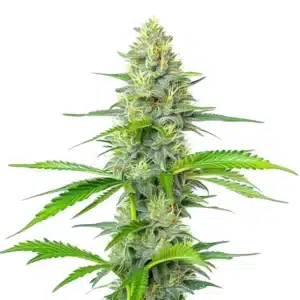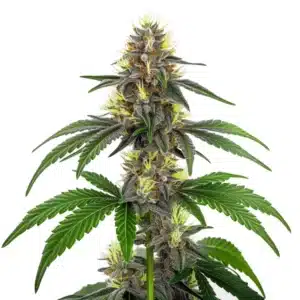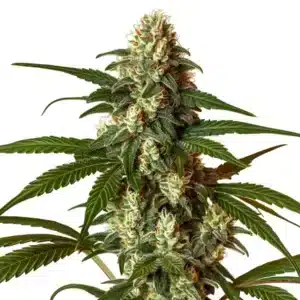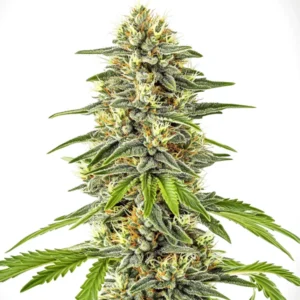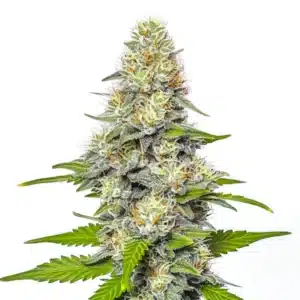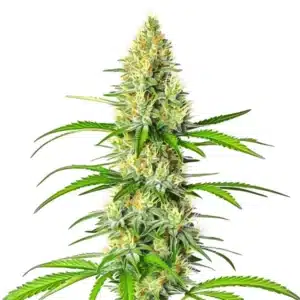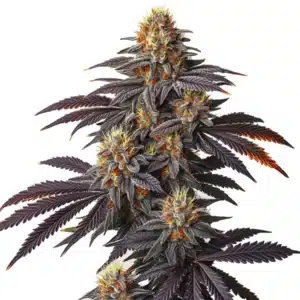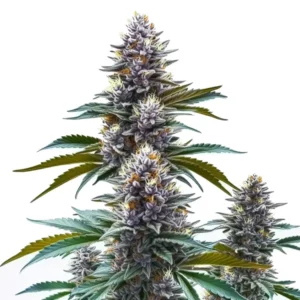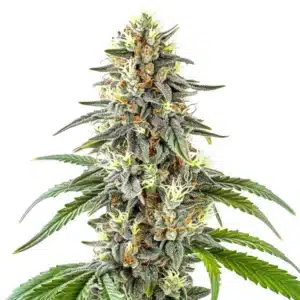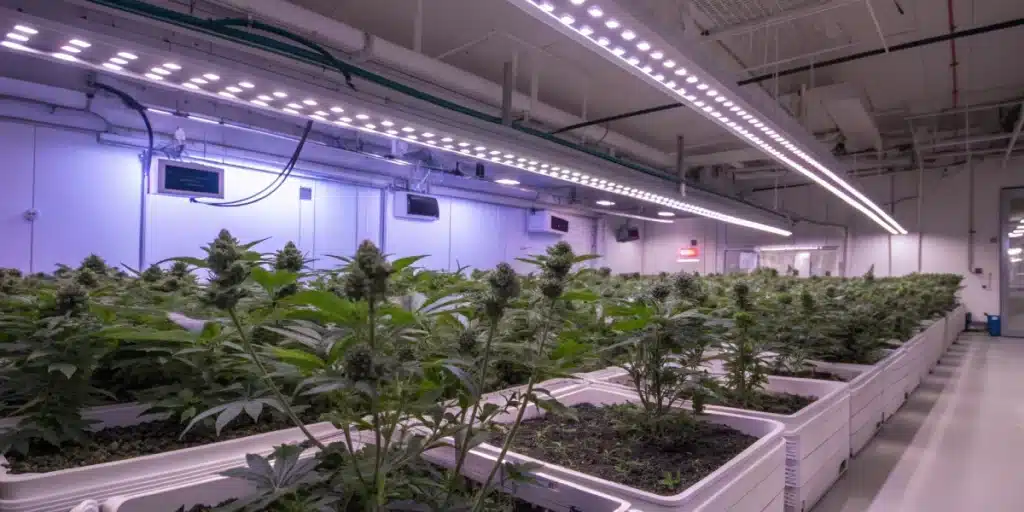
How To Grow Blueberry Widow Strain
Blueberry Widow Strain Description
Blueberry Widow Strain or Blueberry x White Widow is a high THC, feminized cannabis variety created from a cross between Blueberry and White Widow. With THC levels ranging from 22% to 27% and very low CBD, this strain delivers a strong and relaxing experience that is perfect for calming the mind and body. Its genetic makeup is 60% Indica and 40% Sativa, making it mostly Indica, which results in a soothing, mellow effect ideal for alleviating fatigue, muscle spasms, and stress.
The buds of Blueberry Widow are moderately dense and highly resinous, contributing to its reputation as a high yield strain. Expect yields of about 1.64 to 1.97 oz per square foot (500-600 gr/m²) and up to 21 oz per plant. The plant typically reaches a height of around 4.92 ft (1.5 m) and has a flowering time of 8 to 10 weeks. Its flavor profile is a delightful blend of berry, fruity, and sweet notes, while the terpene profile includes compounds such as Alpha-Pinene, Alpha-Terpineol, Beta-Caryophyllene, Beta-Pinene, Caryophyllene Oxide, Delta-3-Carene, Gamma Terpinene, Humele, Humulene, Limonene, Linalool, and Myrcene.
Recommended Strains
Blueberry x White Widow
|
|
THC | 22% - 27% (High) |
|
|
Type | Feminized |
|
|
Yield | High |
|
|
Phenotype | 60% Indica / 40% Sativa |
CBD White Widow (1:1)
|
|
CBD | 6% – 7% (Low) |
|
|
Type | CBD Feminized |
|
|
Yield | Medium |
|
|
Phenotype | 60% Indica / 40% Sativa |
Promos & Deals
Growing Environment
Blueberry Widow thrives in a stable, well-regulated environment. Indoor growers should maintain daytime temperatures between 70°F and 80°F (21°C-27°C) with slightly cooler nights to support bud development. During the vegetative phase, maintain humidity between 60% and 70%; reduce it to 40%-50% during flowering to prevent mold and enhance resin production. Use high-quality LED or HPS lights, offering 18-20 hours of light during early growth and switching to a 12/12 light/dark cycle when flowering begins.
For outdoor cultivation, select a sunny spot with well-draining, nutrient-rich soil. Enrich the soil with compost or worm castings, and use simple windbreaks to protect the plants from strong gusts. Regular monitoring and active adjustments to temperature, humidity, and light conditions will help ensure a rewarding harvest.

Setting Up Your Grow Space
Blueberry Widow Strain Indoor Cultivation
Set up a dedicated indoor grow area, such as a grow tent or small room, with reflective walls to distribute light evenly. Install oscillating fans and an exhaust system with a carbon filter to control heat and odors. Begin Blueberry Widow in small pots filled with high-quality soil and maintain a pH between 6.0 and 6.5. Transplant the seedlings into larger containers as they grow, providing ample room for root expansion.
This controlled setup lets you closely monitor and actively adjust environmental factors, ensuring that your plants develop robustly and enter the flowering phase strong.
Blueberry Widow Strain Outdoor Cultivation
Choose a location with full sun and prepare the soil by incorporating organic matter such as compost or worm castings. Raised beds or large containers improve drainage and control soil quality. Install windbreaks to shield your plants from harsh winds, and follow a regular watering and maintenance routine to keep the area clean and fertile.
Active outdoor care helps Blueberry Widow thrive naturally, resulting in a bountiful yield and consistent performance throughout the growing season.
Seed Propagation and Germination
Start with high-quality feminized seeds of Blueberry Widow from a reliable supplier. Soak the seeds in distilled water or place them on a damp paper towel for 24-48 hours to soften the seed coat and trigger taproot emergence. When a small taproot appears, plant the seed in a container with light, well-draining soil.
Maintain a temperature between 75°F and 80°F (24°C-27°C) and humidity around 60%-70% until the seedlings develop their first true leaves. Gradually increase the light intensity as they grow. These careful steps lay a strong foundation for vigorous development throughout the entire growth cycle.
Vegetative Phase
During the vegetative phase, Blueberry Widow grows rapidly and builds a sturdy structure. Provide 18-20 hours of light per day to promote robust leaf and stem development, and use a nitrogen-rich fertilizer to support healthy growth. Employ active training techniques such as low-stress training (LST) or topping to create an even canopy that allows light to reach every part of the plant.
Close monitoring of temperature, humidity, and watering is essential during this phase. Consistent care during the vegetative stage sets the stage for dense, high-quality bud formation during flowering.
Blueberry Widow Strain Flowering Phase
When it’s time to flower, change the light cycle to 12 hours on and 12 hours off. Blueberry Widow then channels its energy into producing thick, resinous buds that capture its signature berry and fruity sweetness. Feed the plants with fertilizers high in phosphorus and potassium to enhance bud development during this phase.
Maintain cooler temperatures (65°F-75°F) and lower humidity (40%-50%) to prevent mold and maximize resin production. Support heavy branches with stakes or trellises if needed, and inspect the buds regularly with a magnifier. Harvest when most trichomes turn milky with some amber for a premium yield.
Fertilization and Nutrition
Proper feeding is key to a successful Blueberry Widow crop. Start with a nitrogen-rich fertilizer during the vegetative stage to encourage robust foliage, then transition to a blend high in phosphorus and potassium during flowering to support bud growth. Keep the pH steady between 6.0 and 6.5 to ensure optimal nutrient absorption. Many growers also incorporate organic supplements such as compost or worm castings to further enrich the soil, enhancing both yield and flavor.
Regularly review your watering schedule and adjust nutrient doses as necessary. Active nutrient management is essential to maintain healthy, productive plants throughout their life cycle.
Blueberry Widow Strain Pest and Disease Control
Maintain a clean grow space and inspect your Blueberry Widow plants daily for pests like spider mites, aphids, or thrips. Use organic treatments, such as neem oil, at the first sign of infestation. Ensure good airflow and promptly remove dead leaves to reduce the risk of fungal diseases. If any mold or mildew appears, remove the affected areas immediately and adjust humidity levels accordingly.
Quick and active responses to pest or disease issues are vital for keeping your plants healthy and ensuring a successful harvest.
Harvesting and Curing
When most trichomes on Blueberry Widow turn milky with hints of amber, it’s time to harvest. Use clean, sharp tools to carefully cut the branches. Dry the buds in a dark, well-ventilated area with temperatures maintained between 60°F and 70°F, ensuring ample space for air circulation.
After drying, cure the buds in airtight glass jars. Open the jars daily during the first week to release excess moisture, then let the buds cure for 2-4 weeks. This process refines the flavor and potency of Blueberry Widow, preserving its unique berry, fruity, and sweet aroma along with its strong relaxing effects.
Blueberry Widow Strain Indica or Sativa?
Blueberry Widow Strain is mostly Indica with a genetic composition of 60% Indica and 40% Sativa. This blend delivers a strong, relaxing experience that soothes the body and calms the mind, resulting in a calming, happy, and relaxed state. It is ideal for relieving fatigue, muscle spasms, and stress, making it a popular choice for those seeking a mellow yet effective high.
Advantages and Disadvantages
Advantages: Blueberry Widow produces aromatic, resinous buds with a delightful blend of berry, fruity, and sweet flavors. It offers high yields, a strong relaxing effect, and adapts well to both indoor and outdoor cultivation. Its forgiving nature makes it an excellent option for beginners.
Disadvantages: Its high THC levels may be overwhelming for some users. Additionally, careful nutrient and environmental management is necessary to maintain its delicate flavor profile, and extra support might be needed during flowering due to the plant’s structure.
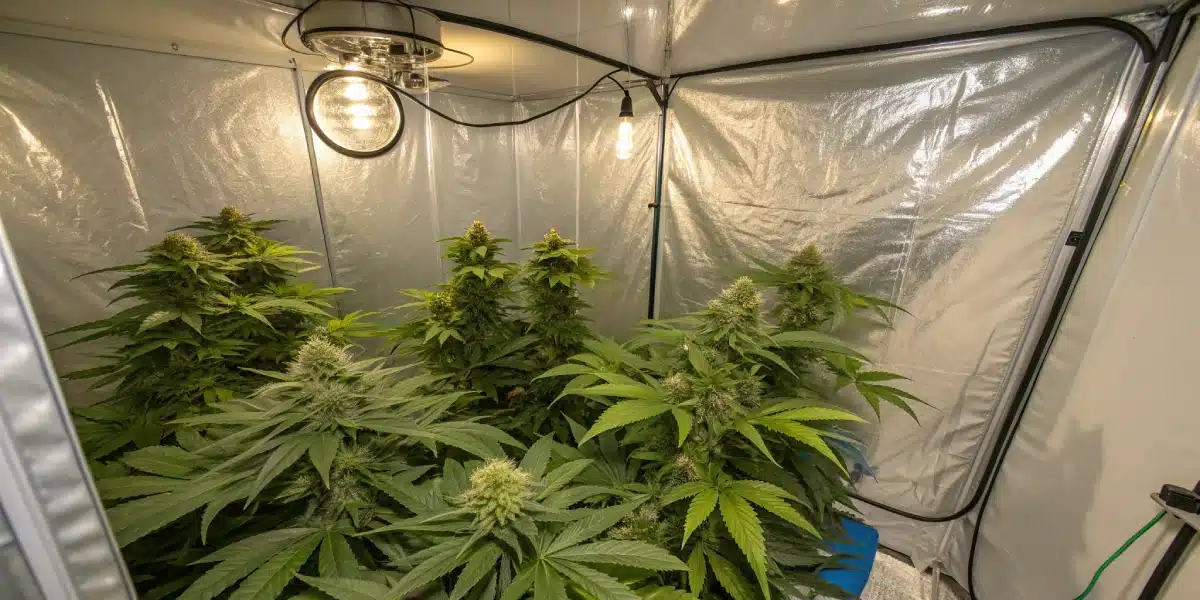
Why Buy Blueberry Widow Strain
Choose Blueberry Widow if you are looking for a strain that combines a unique, flavorful profile with a strong and relaxing experience. Its high THC content and balanced effects make it ideal for managing fatigue, muscle spasms, and stress. Perfect for beginners, this strain offers high yields, a relatively short flowering period, and consistent performance, making it a rewarding choice for both recreational and medicinal users.
Common Growing Problems
Watch for nutrient imbalances, improper watering, and pest infestations. Overfeeding, underwatering, or neglecting environmental controls can stress your plants. Regular monitoring and prompt corrective actions will help keep your Blueberry Widow crop healthy and productive throughout its growth cycle.
Blueberry Widow Similar Strains
White Widow: White Widow is a classic strain with a balanced blend of Indica and Sativa effects. It provides a euphoric and relaxing experience with a pungent, earthy aroma that complements the fruity notes of Blueberry Widow.
Blue Dream: Blue Dream is celebrated for its fruity, berry flavor and well-rounded effects. It delivers an energetic yet calming high, making it a favorite for those who enjoy a similar profile to Blueberry Widow.
Tips for Professionals
For experienced growers, fine-tuning every detail is essential. Use timers and quality sensors to maintain consistent light cycles, temperature, and humidity. Keep detailed records of nutrient adjustments, watering schedules, and environmental changes so you can quickly spot and correct any issues. Incorporate organic supplements and microbial inoculants to enhance soil health and nutrient uptake. Experiment with advanced training techniques, such as super cropping or defoliation, and monitor your plants closely to refine your cultivation methods continuously. A proactive, hands-on approach combined with modern technology will help you consistently achieve premium yields with Blueberry Widow.
FAQs
What makes Blueberry Widow Strain unique?
Blueberry Widow is unique for its high THC levels (22%-27%) combined with a delightful blend of berry, fruity, and sweet flavors. Its mostly Indica genetics deliver a strong, relaxing experience that soothes fatigue, muscle spasms, and stress, making it a versatile choice for both recreational and medicinal use.
How long is the Blueberry Widow Strain flowering period?
The flowering period typically lasts between 8 and 10 weeks. During this time, the buds develop dense resin and the trichomes turn milky with hints of amber, indicating peak potency and flavor.
Can I grow Blueberry Widow Strain outdoors?
Yes, Blueberry Widow thrives outdoors when planted in a sunny location with well-draining, nutrient-rich soil. Regular care, including proper watering, wind protection, and soil enrichment, will result in a high-yield, healthy crop.
What nutrients does Blueberry Widow need?
During the vegetative stage, use a nitrogen-rich fertilizer to promote strong foliage. When flowering, switch to a blend high in phosphorus and potassium to support bud development. Maintaining a pH between 6.0 and 6.5 is crucial for effective nutrient uptake.


